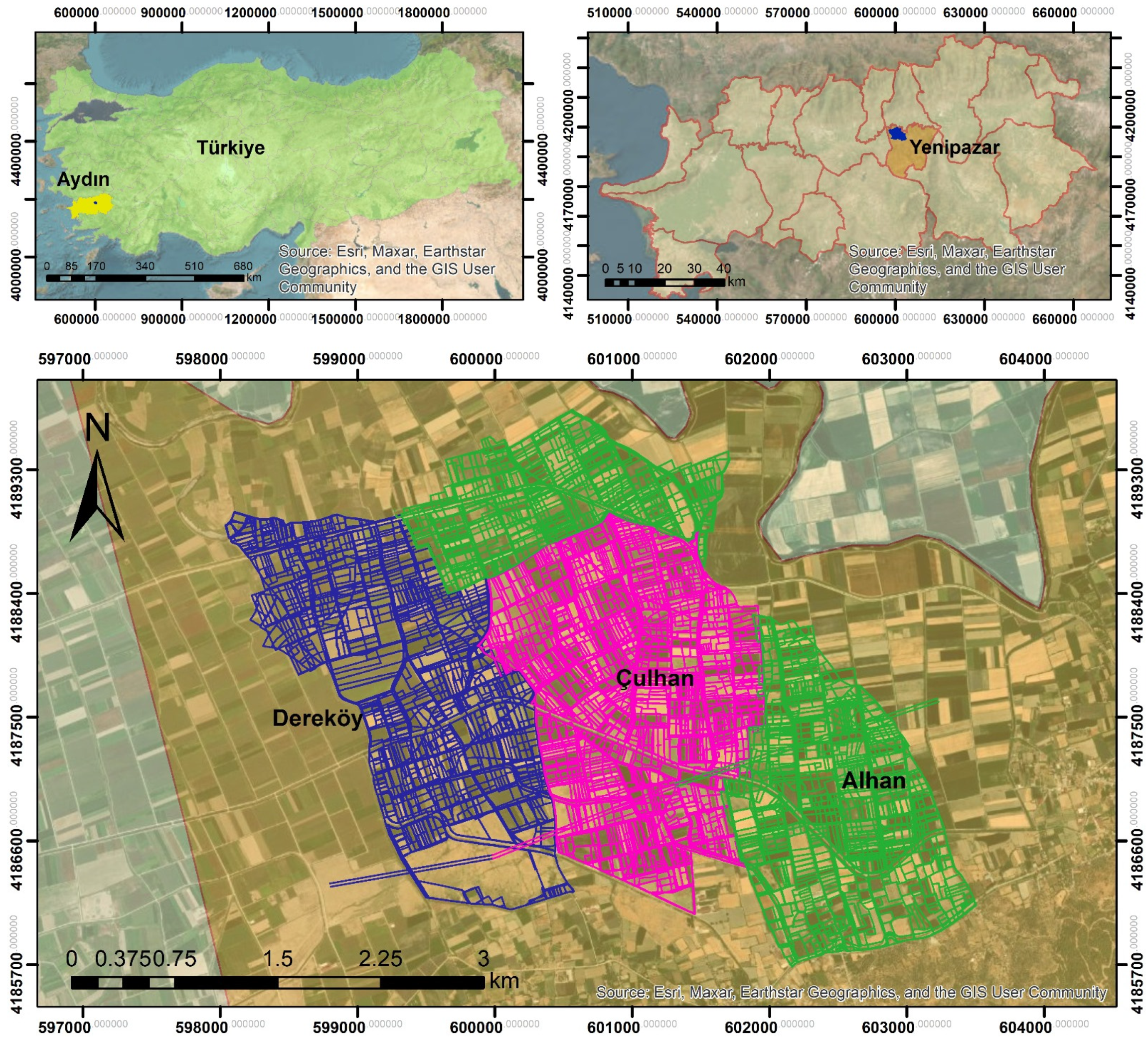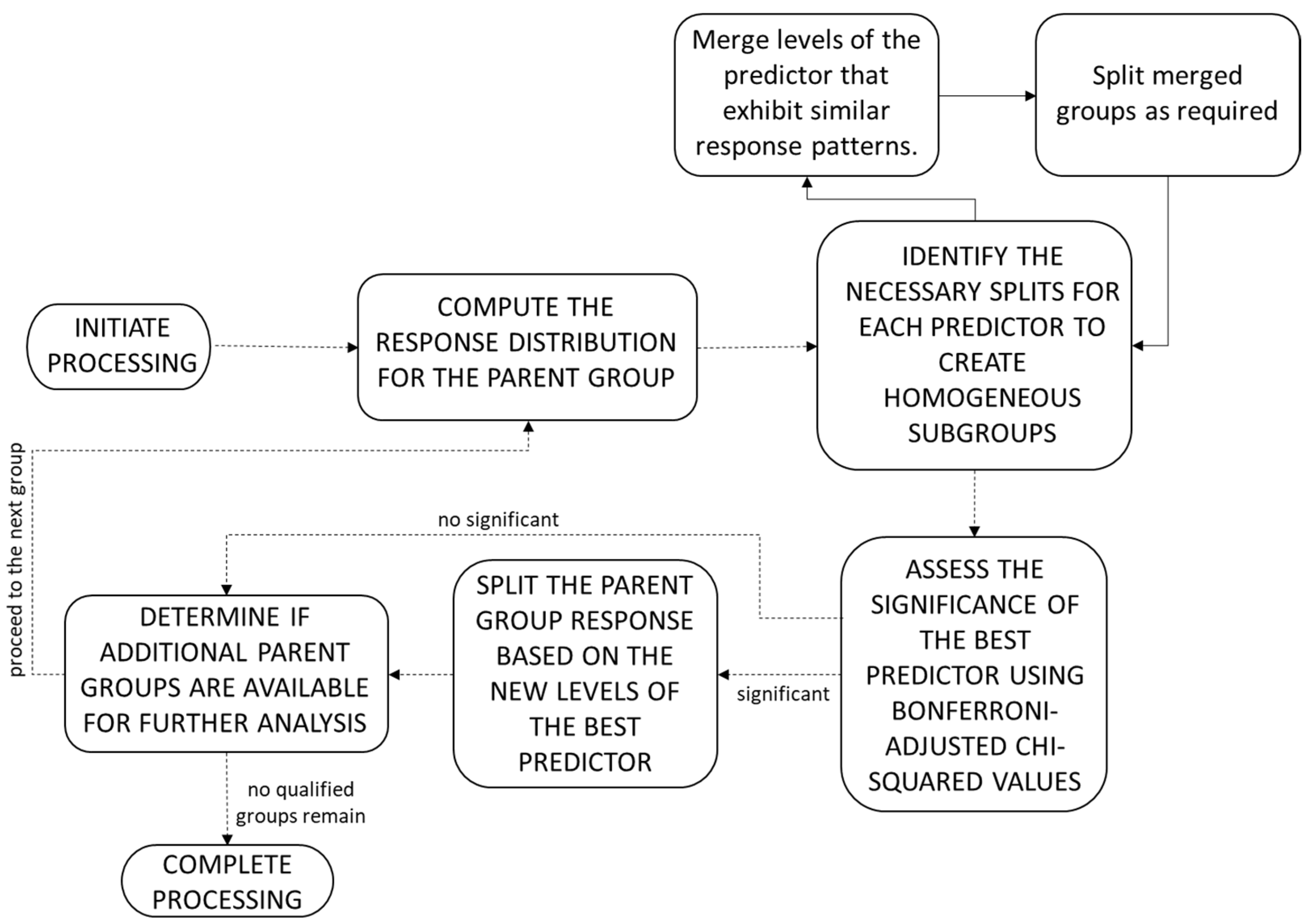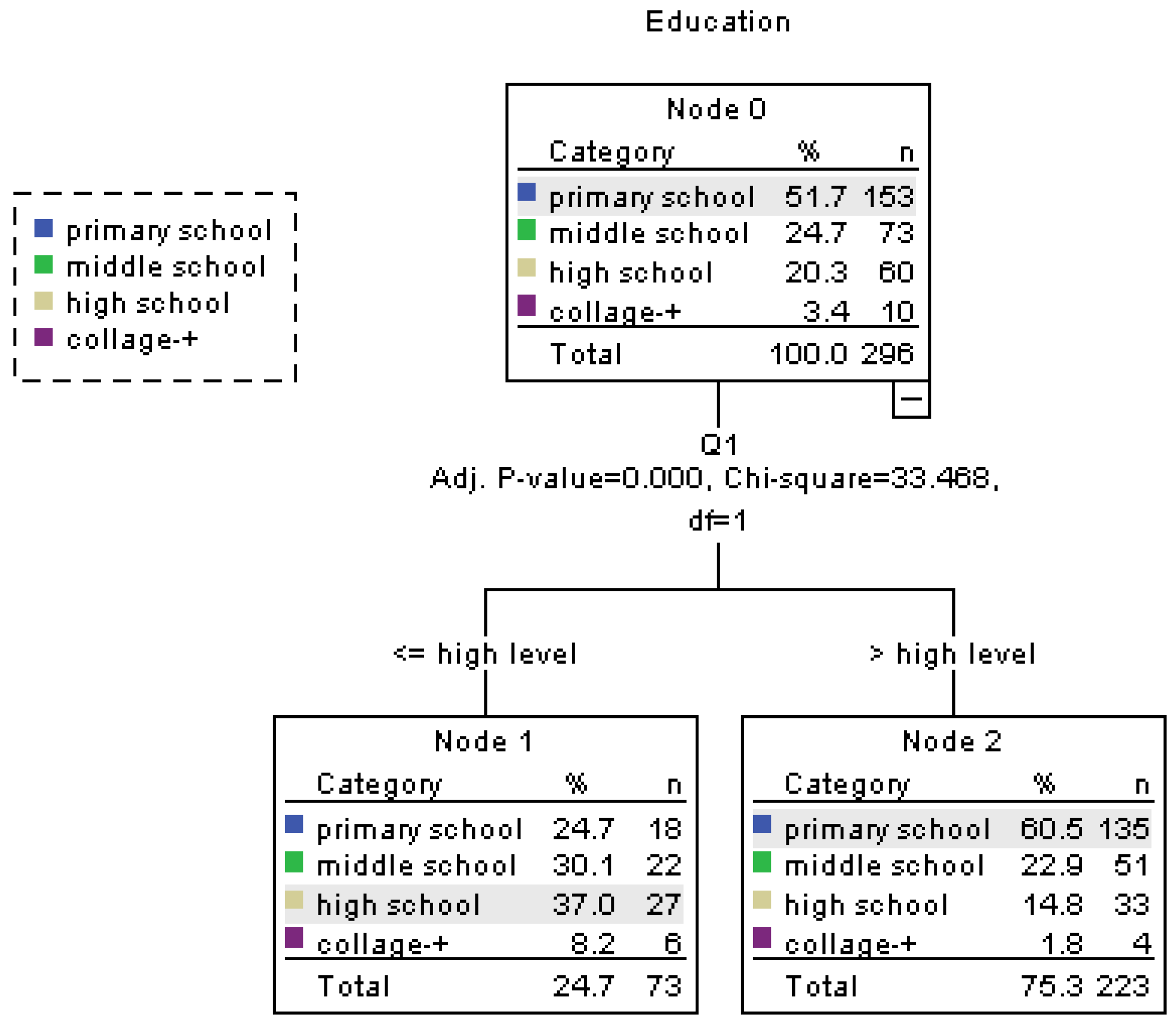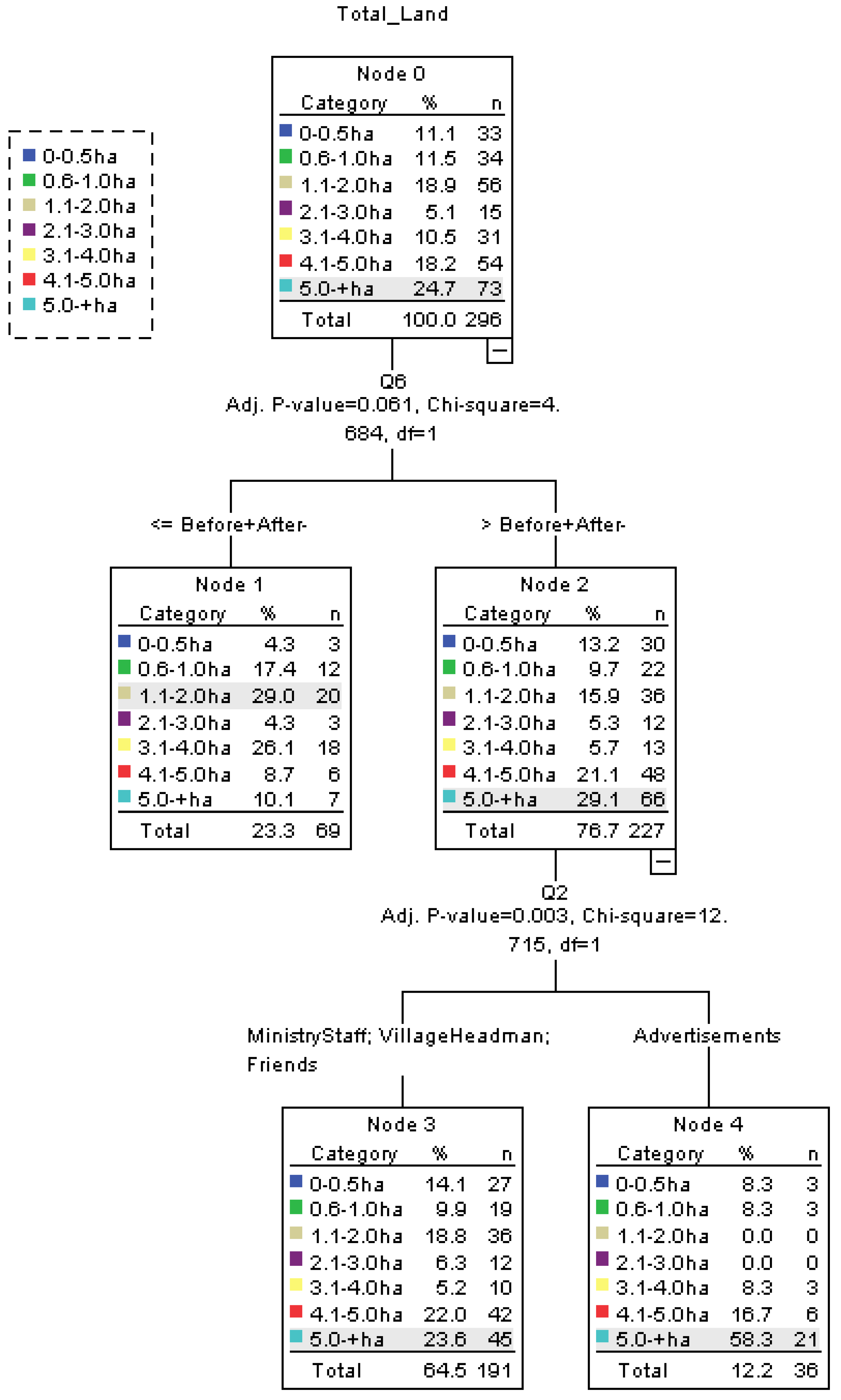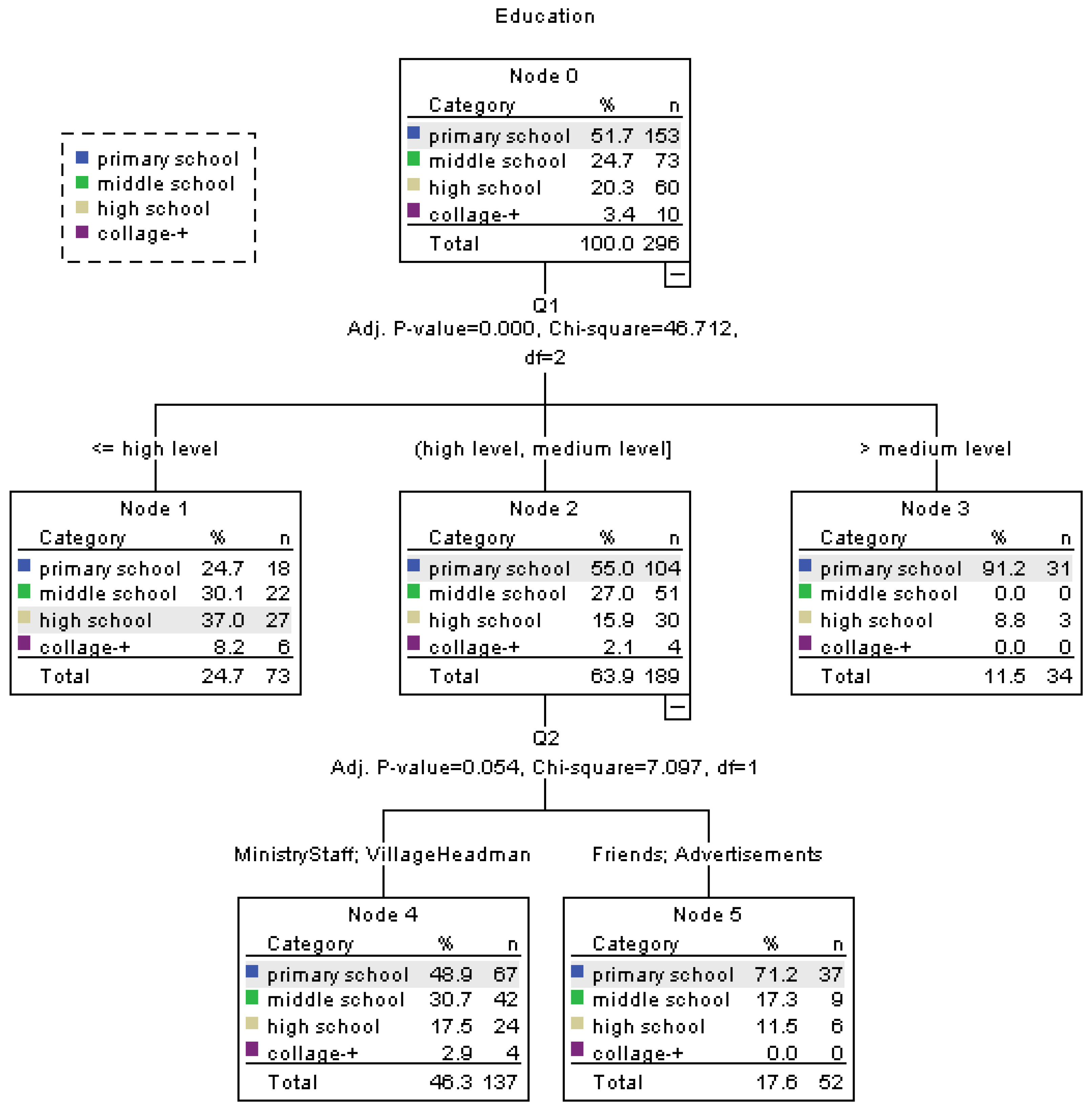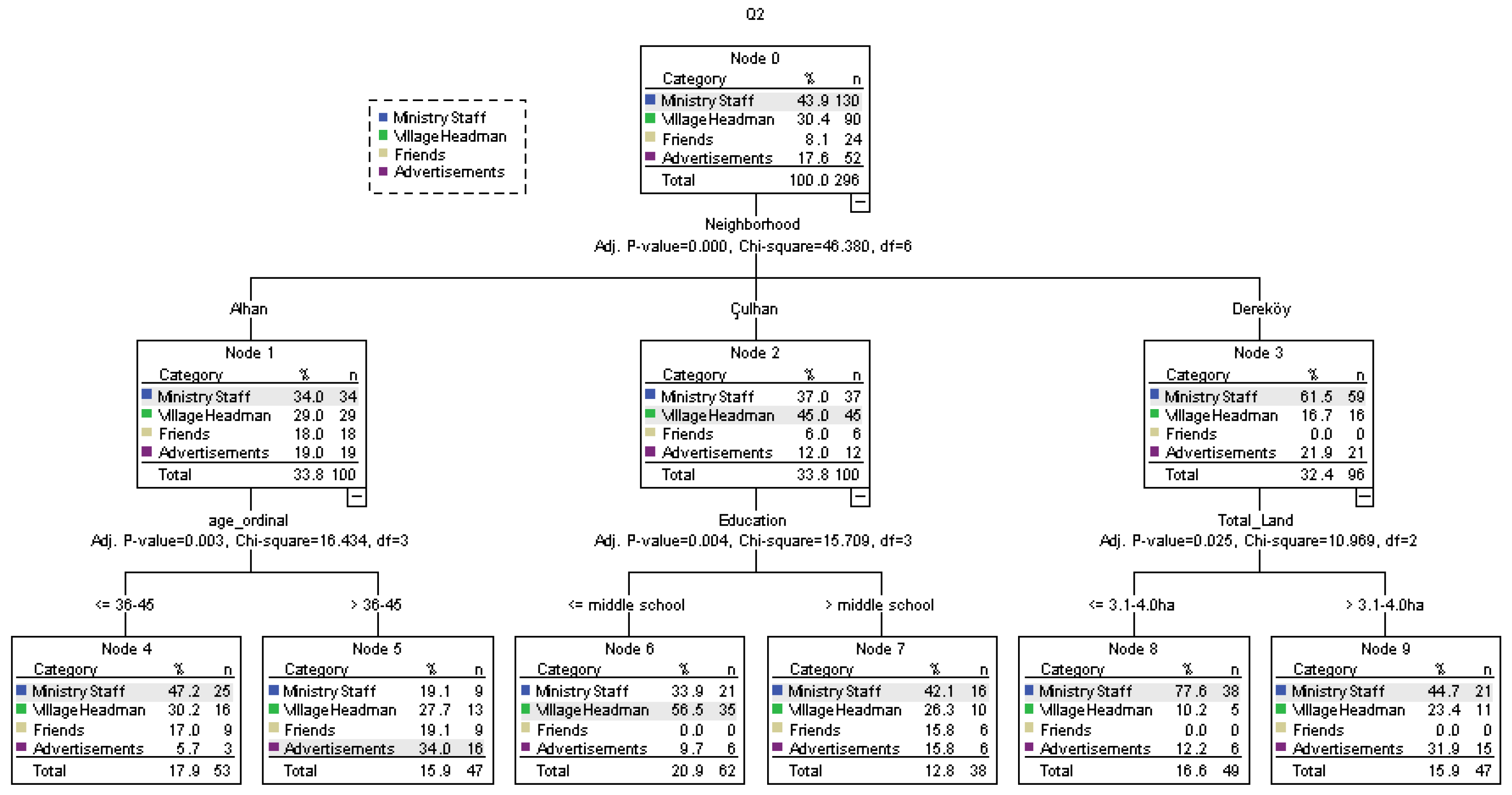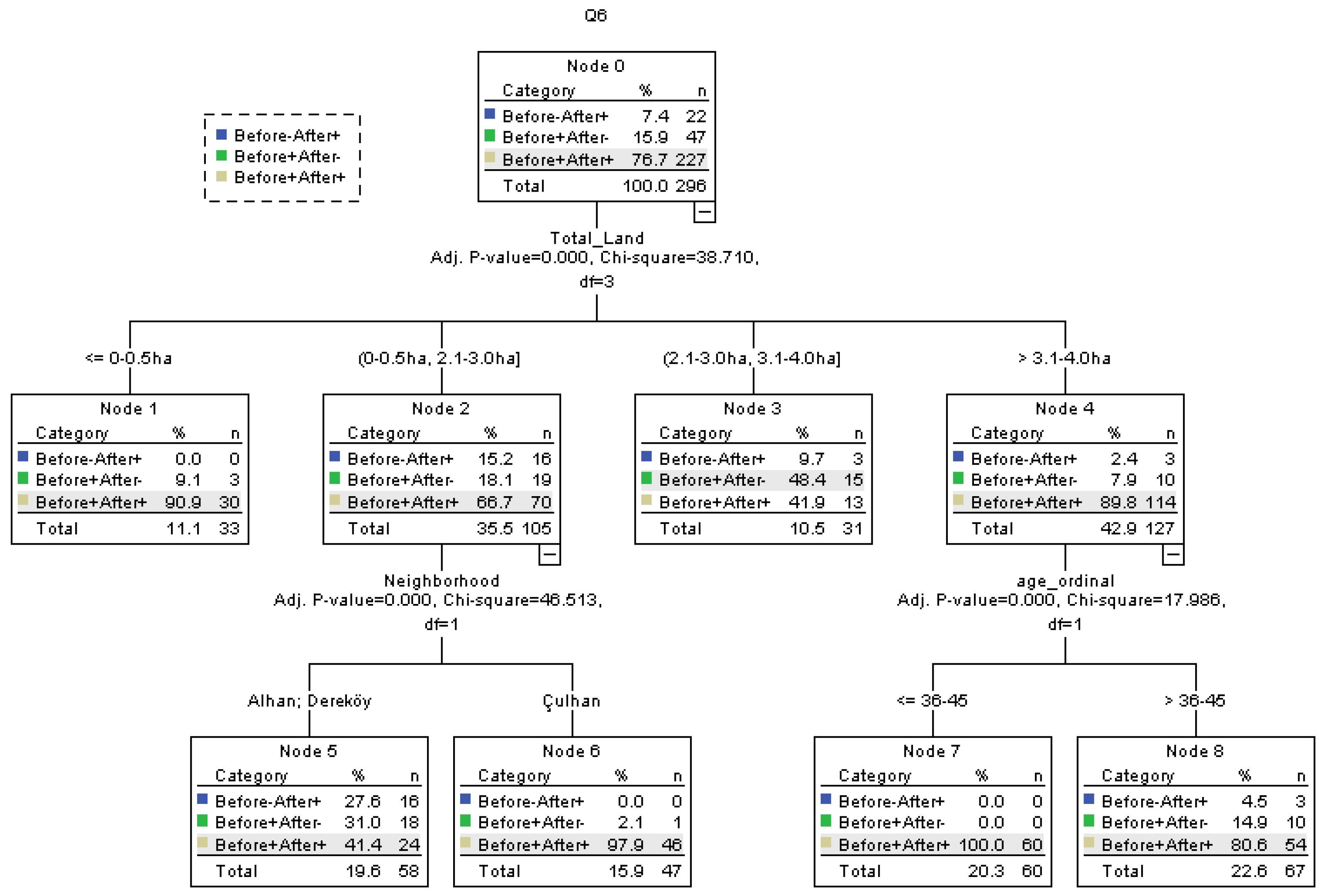1. Introduction
In order to protect the existing agricultural areas of countries and to ensure the effective and sustainable use of these lands, it is necessary to take some measures to increase the living standards of the population living in rural areas [
1]. The most important of these measures is land consolidation (LC) studies, which are among the rural area arrangement activities [
2]. LC studies, which are a basic requirement for sustainable agricultural production in today’s agricultural sector, are a method used to increase the productivity of agricultural lands, improve irrigation systems, and prevent erosion [
3].
Among the most important projects for sustainable land management and sustainable agriculture, Land Consolidation Projects (LCPs) are more than just combining fragmented lands belonging to enterprises scattered in different parts of the basin, divided into multiple pieces, and unsuitable for agriculture. At the same time, they aim to increase agricultural production per the principles of modern agricultural management and benefit from irrigation services [
4].
LCPs in Turkey typically comprise two stages. The initial phase involves consolidating, shaping, and rearranging parcels of land in the project area that are fragmented, scattered, and distorted to an extent that renders agricultural activities uneconomical. These activities are carefully executed to ensure compliance with modern agricultural management principles and irrigation services. On-Farm Development Services (OFDS) projects, such as farm drainage, agricultural road construction, and land reclamation, are implemented during the second phase.
The initial large-scale LCP in Turkey was implemented in 1961, located in Karkın village, Çumra District, Konya, as a research project prior to the co-investment of the United Nations Food and Agriculture Organization (FAO) and the State Planning Organization (DPT). Subsequent large-scale LCPs were executed in 1967 within the territories of Manisa and Izmir provinces, Turgutlu, Manisa, and Menemen Plain, to advance agricultural productivity and enhance irrigation systems [
4].
Table 1 displays the completed LC reports in Turkey.
Table 1 shows that research on LCPs in Turkey began to gain momentum in 2002. Even more significant momentum was gained after 2008, when the Southeastern Anatolia Project (GAP) was implemented. The Ministry of Agriculture and Forestry in Turkey has planned to consolidate all of the technically and economically irrigable lands by the end of 2023. Their primary goal is to consolidate 14 million hectares of agricultural land that is currently open or will be opened for irrigation. The aim is to complete the first generation of consolidation studies in Turkey [
5].
Numerous criteria are available for evaluating the success of LCPs, the most important of which is the evaluation of the overall satisfaction of the farmers. Since the LCPs’ outcomes directly impact farmers, their satisfaction, their level of knowledge, and a good assessment of their perspectives on the projects will contribute significantly to the success of future LCPs.
In order to carry out a comparative analysis of rural areas in different European countries, it is necessary to use a research methodology that includes both a comprehensive literature review and a statistical analysis. Thus, an overview of the current situation in rural areas will be provided. Data from the interview will be helpful for future development, including average farm size, age of farmers, rural density, and other key information. Additionally, the analysis of sustainable rural areas would be a valuable contribution to this review [
6].
Numerous studies, both globally and in Turkey, have endeavored to comprehend the response and conduct of farmers towards LC.
A technique used in Land Consolidation Projects (LCPs) in northwestern Portugal aimed to determine how individuals’ characteristics and perceptions affect their propensity to adopt innovations. For this purpose, the impact of household characteristics on the adoption of selected agricultural innovations in the Valença-LCP was investigated. The study found that the farmers most likely to adopt new agricultural equipment and technology were younger, better-educated householders who had been farming all their lives, producing primarily for the market on large farms [
7]. Furthermore, a study was conducted to investigate the effects of LC and fragmentation after land privatization in Albania, surveying 15–20 farmers in each of the three villages. They also consulted regional agricultural experts to collect information on the issues faced in those areas. The study aimed to determine the level of land fragmentation in the region, identify its advantages and disadvantages, and establish the LC methods employed. They discovered that farmers usually possess three distinct qualities or categories of land. A total of 31.8% of the farmers surveyed regarded having all three land categories as a benefit of fragmentation. Also, it was discovered that, in certain circumstances, although arable land is homogeneous and falls within the same category, farmers still opt to have distinct plots [
8].
Furthermore, 42 semi-structured surveys were conducted with a random sample of 10% of the villages in a region in the Northern Mountains of Galicia (NW Spain). The study aimed to identify the potential of farmer knowledge as a source of information about past and present cultural landscapes, focusing on land use systems, cultural heritage, and farmer perception of landscape changes over approximately 50 years from the 1950s. The study revealed an apparent uncertainty about LC, possibly due to cultural factors such as the Galician farmers’ strong attachment to the land (’their roots’). Despite agreeing on the technical and economic advantages of having their farms on a single, large plot, they resisted surrendering their beloved land while exchanging it to consolidate the land and expand farm ownership [
9].
A study was conducted in Slovenia to assess landowners’ perception of LC and their satisfaction with the results. Their findings suggest that the active participation of landowners contributed to their understanding of the objectives of LC and satisfaction with the outcomes [
10].
Furthermore, a study was conducted in Dongnan Village, Shandong Province, China, to determine stakeholders’ perspectives on the LC program. They reported that attitudes towards the LC program varied depending on the age and occupation of the farmers [
11].
A study was conducted on the effectiveness of LC in Hamzabali village, Yenipazar district, Aydın province. The authors emphasized the importance of implementing LCP in conjunction with irrigation projects. During the interviews conducted in the study, farmers expressed that irrigation channels should be renewed [
12]. In addition, a study was conducted to determine farmers’ level of awareness and satisfaction regarding LC in the same region of Turkey. The study analyzed the land assets of 161 owners, their willingness to join the LC, and their views and thoughts following participation in the LC. The authors concluded that enhancing the enterprise owners’ awareness is a crucial factor for the success of the LCP [
13].
Furthermore, interviews with 90 enterprises were evaluated in a study to determine the effectiveness of the LCP implemented in the Dalama Plain of Aydın Province (Turkey). They compared the results of their evaluation with the data from the pertinent institution. They compared their findings from this evaluation with data obtained from the pertinent institution, using water use efficiency, physical efficiency, and socio-economic efficiency indicators to determine LC efficiency. Following an assessment of interviews with farmers, it was concluded that irrigation investments must be planned alongside the LCP. Additionally, the significance of utilizing mass media in LCPs to increase the owners’ awareness of LC was emphasized [
14].
In a study investigating how agricultural land protection methods affect the spatial characteristics of transferred lands, land survey data in China were evaluated. The study’s conclusion underlines the urgent need for an integrated agricultural land transfer trading system and strengthened policy measures to promote land consolidation to encourage widespread adoption of these conservation strategies. It is crucial to evaluate land consolidation projects separately on a regional basis [
15].
Ineffective agricultural extension activities, which are important in increasing agricultural productivity and developing the agricultural sector, significantly reduce the expected benefits [
16]. It was reported that the legal regulations in LC studies should be explained well to farmers; otherwise, farmers may have a negative attitude towards land consolidation projects in Turkey. This situation may be an obstacle to voluntary consolidation projects [
17].
For the reasons mentioned above, there is a need for detailed studies to evaluate the effectiveness of extension policies in land consolidation studies. Thus, preparations should be made before starting the projects, especially for regional needs, and these projects can be explained to farmers correctly. Different methods are applied while studying projects in every country and even in every region within the country. A good analysis of these methods will significantly contribute to determining the paths to be followed during the interview studies of future projects in that region. For this purpose, we conducted a satisfaction interview to understand the views of farmers on LC and OFDS projects completed in 2011 in the villages of Aydın Yenipazar Plain Alhan, Çulhan, and Dereköy. The results of the interviews were evaluated using the CHAID analysis model.
3. Results
This section examines the outcomes of interviews conducted in the Alhan, Çulhan, and Dereköy neighborhoods. General information about the participating farmers is presented in
Table 3. Furthermore, all variables presented in
Table 3 were employed in the CHAID analysis to assess farmers’ perspectives on regional land consolidation projects. The findings illustrated in
Figure 3,
Figure 4,
Figure 5,
Figure 6,
Figure 7,
Figure 8,
Figure 9,
Figure 10,
Figure 11 and
Figure 12 are derived from this analytical process.
When assessing the interviewed farmers collectively, it was noted that the majority fell within the 35–54 age group. This observation serves as a notable illustration, suggesting that, particularly in recent years, the youthful demographic in Turkey has been relocating to urban centers with the anticipation of improved living conditions. The data further reveal that a substantial proportion of the interviewed farmers, approximately 85%, are married, and around 40% have completed primary school education. Additionally, albeit in smaller numbers, farmers with a university or postgraduate level of education also participated in the interview.
When land asset values in the study area are examined, it is seen that the most significant proportion is 5 ha and above (24.66%). When the interview questions examined in the study were evaluated in general, it was seen that most farmers interviewed (approximately 64%) had a moderate level of knowledge about land consolidation. Approximately 44% of the farmers reported that they learned from the Ministry staff that a land consolidation project would occur in their villages.
When the farmers’ perspective on consolidation projects was evaluated, it was observed that a significant part of them had a positive opinion both before and after the project, and there were no farmers who expressed a negative opinion before and after the project. Approximately 57% of the farmers reported a positive change in their living standards after the project, and 57% reported that their expectations from the project were partially met (
Table 3).
Figure 3 illustrates the fulfillment of expectations from the land consolidation project based on the neighborhoods. The gray shades in
Figure 3 and other decision tree figures represent the maximum value of the relevant node. As a result of evaluating the villages where the project was implemented as the dependent variable, the most distinctive feature was the rate of meeting the expectations from the project. The rate of enterprises reporting that their expectations from the LCP were met in all villages was 32.8%. When examined on a neighborhood basis, the best results were Alhan (52.6%), Çulhan (35.1%), and Dereköy (12.4%), respectively. When we look at the enterprises that say partially met/not met, it is seen that they are Alhan (24.6%), Çulhan (33.2%), and Dereköy (42.2%), respectively. Again, the most damaging results in terms of the level of meeting expectations from the project occurred in the Dereköy neighborhood. Based on this, it can be said that the village most satisfied with the project is Alhan, and the neighborhood least satisfied is Dereköy. At the second node, the enterprises stated that their expectations from the LCP were met; the answer “Have your living standards changed positively due to land consolidation”? was examined, and 71.4% of those who said “no” were from the Alhan district. Alhan was followed by the Çulhan (21.4%) and Dereköy (7.1%) neighborhoods. The percentage of those who answered “yes” to the same question was Çulhan (45.5%), Alhan (38.2%), and Dereköy (16.4%), respectively. These results show that enterprise owners generally think that, although their expectations from ATP are met, this situation does not impact their living standards. At the third node, the question “Where did you learn about LC”? was asked among the enterprises that stated that their expectations from the LCP were partially or not met. When the answers to the questions were examined, 40.2% said they learned LC from Ministry staff and advertisements. When we look at the distribution on a neighborhood basis, it is seen that the most significant rate occurs in the Dereköy neighborhood (57.1%). Again, the most significant proportion of those who answered “Village headman” and “friend” to this question is seen in the Çulhan neighborhood (51.2%). Among the enterprise owners who stated that their expectations from the LCP were partially met/not met and that they learned about the LCP from Ministry staff/advertisements, 54.7% of the enterprises reporting that their living standards had changed positively were from the Dereköy neighborhood. Again, the enterprises that answered no to this question were mainly from the Dereköy neighborhood (60%).
The interview results are examined in
Figure 4, considering the age-dependent variable. Enterprises reporting that their living standards have changed positively after the LCP constitute 56.8% of the total enterprises. Here, the highest rate occurred in the 46–55 age range (32.1%), and the lowest rate occurred in the 20–35 age range (18.5%). The level of knowledge about LC in these enterprises is mostly (42.6%) at a medium level/none. Most enterprises with medium level/none are enterprise owners over the age of 46. Enterprise owners with a high-level knowledge about LC are mainly in the 36–55 age group. When the second node of the age-dependent variable is examined, enterprise owners who report no positive change in their living standards after the LCP constitute 43.2% of the total number of interviews. These enterprises were asked where they learned about LCP, and 24.3% reported it was from Ministry staff. Most enterprise owners who gave this answer (58.3%) are between 36 and 45. Of the 18.9% of enterprise owners who learned about LC through other channels (village headman, friends, advertisements), the majority (50.0%) are enterprise owners between the ages of 46 and 55.
When a general analysis is made in terms of educational status, the majority of enterprise owners who say that their knowledge level about LC is medium level or none constitute the majority. A total of 60.5% of these enterprise owners are primary school graduates. A total of 8.2% of the enterprise owners who report having high-level knowledge about LC are enterprise owners with a college education or higher. It has been revealed that the proportions of enterprise owners who are primary, secondary, and high school graduates are similar (24.7–30.1% and 37.0%, respectively). It is thought that this similarity stems from the fact that enterprise owners with a college education or higher prefer the professions for which they have received training rather than dealing with agriculture (
Figure 5).
When total land assets are considered, among the enterprises that gave ‘negative before and after’ or ‘negative before and then positive’ responses about LCP, the largest proportion was comprised of enterprises with 1.1–2.0 hectares of land (29.0%). It was found that 76.7% of the enterprise owners had a positive perspective on LCP before the project. Most of these enterprises have land larger than 4.0 hectares (50.2%). Again, these enterprises were asked where they learned about LCP, and 64.5% said they learned it from Ministry personnel, village headman, and friends. The largest portion of this rate comprised enterprises with land larger than 4.0 hectares (45.6%). The majority of the enterprises that learned about LCP from announcements (12.2%) were enterprises with land larger than 5.0 hectares. As can be understood from this, the abundance of land positively affects the perspective on LCP (
Figure 6).
The findings of the enterprises whose level of knowledge about LC was examined in the dependent variable of educational status are given in
Figure 7. Most enterprises say ’medium-level’ (63.9%) regarding knowledge level. Among these enterprises, the most significant proportion was owned by farmers who were primary school graduates, with 55.0%. Again, the most significant % of answers given to where they learned how to make LC in these enterprises were Ministry staff and village headman, with 46.3%. A total of 48.9% of the enterprise owners who learned about LC from the Ministry staff and the village headman are primary school graduates. Again, 17.6% of the enterprises with medium-level knowledge about LC learned that their friends and advertisements would do the project. Here, the most significant proportion, 71.2%, consists of enterprise owners who are primary school graduates. Within the scope of this evaluation, most enterprise owners who said they had a high-level knowledge about LC (24.7%) consisted of enterprises that were primary school, secondary school, and high school graduates (24.7–30.0–37.0%, respectively). Of the enterprises that reported having no knowledge about LC (11.5%), 91.2% were primary school graduates.
When the knowledge levels of enterprise owners about LC were examined (
Figure 8), it was concluded that most of them had medium-level knowledge. When these enterprises were evaluated regarding land availability, the most crucial difference was among those with land between 1.1 and 4.0 hectares. A total of 45.7% of these enterprises reported that they had no knowledge about LC. In addition, in the fourth node, the age of the enterprise owners became an essential variable in the enterprises that owned land between 3.1 and 4.0 ha. A total of 55% of enterprise owners between the ages of 36 and 45 reported that their knowledge about LC was at a medium level, while the remaining 45% reported that they had a high level of knowledge. The knowledge level of enterprise owners aged 35 and younger changed to 77.6% at a medium level and 22.4% at a high level. The fifth decision node examined the distribution of enterprises among neighborhoods in the 35 and younger age group.
When the answers to the question “How did you learn that a consolidation project would be carried out in your village?” were examined, it was revealed that 43.9% of the enterprises learned from the Ministry staff. This rate is followed by the village headman, with 30.4%. These rates show that Ministry staff and village headmen are active in project information activities. These rates were examined at the neighborhood level in the second-row decision node, with Ministry staff taking the first place, with 34% in Alhan and 61.5% in Dereköy, and village headman with 45% in Çulhan. These results show that Ministry staff can reach enterprises in Alhan, Dereköy, and the village headman in Çulhan. At this stage, the neighborhoods were evaluated within themselves at the third node. When an evaluation is made in terms of age ranges in Alhan, it is seen that enterprises in the 36–45 age group and older mostly learned about the project from Ministry staff (47.2%). In contrast, enterprise owners in the younger age group mostly learned about the project from advertisements (34%). Educational status comes to the fore in the Çulhan neighborhood. It is seen that 56.5% of the enterprises with a secondary school or lower education level learned about the project from the village headman, and 42.1% of the enterprise owners with a secondary school and higher education learned about the project from the Ministry staff. In Dereköy’s neighborhood, total land holdings came to the fore. A significant portion of the enterprises had land assets more prominent than 3.0 hectares (77.6%), while the majority of the younger enterprise owners (44.7%) reported that they learned about the project from the Ministry staff (
Figure 9).
Interviews showed that enterprise owners’ perspectives on LC were generally positive (76.7%) before and after the project was completed. When this ratio is considered regarding the total land amount of farmers, it changed positively before the LC but negatively after the LC in 48.4% of the enterprises with 21–40 da of land. When enterprise owners with less than 31 da of land are evaluated at the neighborhood level, the first place is taken by the enterprises that reported that their perspectives were positive before and after the LC. However, these rates were 41.4% in the Alhan and Dereköy neighborhoods and 97.9% in Çulhan. Based on these results, it can be said that the LC project was quite successful in the Çulhan neighborhood for enterprises with less than 31 da of land, while the same success was not achieved in the Alhan and Dereköy neighborhoods. When the interview was evaluated in terms of the age distribution of the enterprise owners, it was seen that it was positive both before and after LC. However, in terms of proportional distribution, it was revealed that all enterprise owners between the ages of 36 and 45 and older and 80.6% of enterprise owners younger than this age range gave this answer (
Figure 10).
Figure 11 shows the decision tree regarding the change in living standards after LC. When the findings of the first node were examined, it was revealed that the living standards of 56.8% of the interviewed enterprises changed positively due to LC. As a result of comparing these rates with the total land amount values, it was seen that the rate of enterprises that stated that there was no positive change in the enterprises owning land between 21 and 50 da was 75.3%. At the second node, age range and education levels were examined. Among the enterprises with land between 1 and 30 da, 69.8% of the 36–45 and older enterprises stated that their living standards did not change positively. In contrast, 69.4% of the enterprises outside this group stated that their living standards changed positively. These results revealed that the young population was positively affected by LC. Finally, when the education level of enterprises with a total land area of 41–50 da is taken into consideration, it is revealed that the living standards of 71.1% of enterprises with secondary school or lower education level and 97.1% of enterprises with higher education level have changed positively. It is seen that enterprises with high land assets and education levels have more positive results regarding living standards. Net income is an important indicator of an economically sustainable farm’s growth capacity. The long-term profit amount within the farm strategies determines the growth ability of agricultural enterprises. Net income fluctuations may reduce economic sustainability’s power [
29].
According to the findings of the decision tree in which the farmers’ expectations were met, 56.8% of the interviewed enterprises reported that their expectations were partially met due to the LC. When this ratio is evaluated in terms of total land assets, it is revealed that the expectations of 48.9% of the enterprises with only 21–40 da of land assets are not met. In enterprises with land of more than 3.1–4.0 hectares, the majority (59.8%) stated that their expectations were partially met due to the LC. When the results are examined on a neighborhood basis, 55% of enterprise owners in the Alhan and Çulhan neighborhoods and 68.1% in the Dereköy neighborhood stated that their expectations were partially met. Among the enterprise owners in the Alhan and Çulhan neighborhoods, 73.3% of those with land between 3.1 and 5.0 hectares found their expectations were partially met, while those with more than 5.0 hectares were met. Based on these results, it is possible to say that, as land availability increases, the rate of meeting enterprises’ expectations also increases (
Figure 12).
4. Discussion
Many factors affect the diffusion and adoption of innovations in agriculture. The risk behaviors of producers are among these factors. Adopting any technological innovation by producers in a region requires, in addition to a successful dissemination effort, knowledge of the producers’ behaviors toward risk [
30].
When the literature is examined, it is observed that the success of consolidation projects is examined by conducting various interviews with farmers in land consolidation areas in the world and Turkey. A few examples of these studies are given below.
In a study conducted in Dongnan Village, Shandong Province, to determine the perspectives of stakeholders’ perspectives regarding China’s land consolidation program, it was reported that attitudes towards the LC program mostly varied depending on the age and profession of the farmers [
11]. Similarly, the findings from this study also show that the age of the enterprise owners affects their views on the consolidation project. For example, among the enterprise owners with a total land holding of 3.1–4 ha, all (100%) of those younger than 36 reported having a positive opinion of the LC before and after the project.
In a study carried out in the land consolidation project area in Aydin province in Turkey, interviews were conducted with 90 enterprises to determine the effectiveness of the LC project applied in Dalama Plain, and the results from this evaluation were compared with the data obtained from the relevant institution. They used water use efficiency, physical efficiency, and socio-economic efficiency indicators to determine LC efficiency. After evaluating the interviews with the farmers, they concluded that irrigation investments should also be planned with the LC project. They also emphasized the necessity of using mass media in LC projects to raise awareness of LC among the owners [
14]. LCPs in Turkey are generally carried out together with OFDS projects in the region. However, there are regional differences. For example, the LCP and OFDS projects of the Yenipazar plain in Aydın province, which are also the subject of this study, were approved simultaneously, but the LCP of the projects was completed earlier. The drainage works in the region were completed after the land distribution processes. According to the decision tree findings showing the status of meeting the farmers’ expectations used in this study, 56.8% of the interviewed enterprises reported that their expectations were partially met thanks to the LC because the OFDS projects were not completed immediately.
In the study conducted to evaluate landowners’ perception of LC in Slovenia and their satisfaction with the results, they concluded that the active participation of landowners contributed to their understanding of the purposes of land consolidation and their satisfaction with the results [
10]. A study was conducted to determine farmers’ levels of awareness and satisfaction about LC in Çanakkale Biga district, Turkey. The study examined 161 owners’ land assets, their willingness to join the LC, and their ideas and thoughts after the LC. In the research, they concluded that increasing the awareness of enterprise owners is very important in the success of the LCP [
13]. However, this study concluded that farmers’ education level, land holdings, and age were more effective in satisfaction.
In a survey conducted with 50 agricultural enterprise owners in Yörük Village in Malkara district of Tekirdağ province, Turkey, the aim was to examine the farmers’ thoughts on the ongoing land consolidation process, the factors that are effective in adopting consolidation, and the problems arising from consolidation. The information before and after the parcellation, road, and irrigation connections and the relationships between production resources were examined, which could evaluate the producers’ perspectives on land consolidation. In the study, it was determined that, although 66% of the farmers attended the information meeting, 90% did not give their consent for consolidation. As a result of the factor analysis, the farmers’ opinions on land consolidation were collected under five headings (information, economic satisfaction, structural satisfaction, social changes, and agricultural satisfaction). It can be supposed from the study that most of the information provided by friends, neighbors, and the headman affected this situation. Therefore, it was concluded that more comprehensive and long-term training and information should be provided to farmers by the authorized institutions on land consolidation [
31]. According to the survey conducted within the scope of our study, a large portion of the business owners learned that the land consolidation project would be carried out by the Ministry staff (43.9%) and the village headman (30.4%). These values show that the Ministry staff and the village headman were active in the project area. As a result, the importance of agricultural extension activities can be seen from the results of this survey.
A study evaluating land consolidation studies conducted in five neighborhoods in the Tarsus district of Mersin province, Turkey, aimed to determine the effect of shareholding change on land consolidation success. Within the scope of the study, shareholding change, the consolidation ratio over the number of shares, average number of parcels per owner, average number of shares per owner, parcel status of owners, and average parcel size indicators were evaluated. In addition, a survey was conducted with landowners regarding shareholding change. As a result of the study, it was reported that there was a significant increase in shareholding change with the land consolidation study. In addition, it was determined that the satisfaction level of the owners with the land consolidation study was quite low. In the surveys conducted within the scope of the study, it was concluded that the increase in land fragmentation and the number of shared parcels decreased farmer satisfaction [
32].
5. Conclusions
When the findings obtained from this study, which primarily evaluated farmers’ perspectives, are examined in general, the perspectives of enterprise owners on LCPs vary depending on the neighborhood, age, education level, and the amount of land they own. For example, when evaluated on a neighborhood basis, a significant portion of the enterprises (52.6%) who stated their expectations from the project were met are located in Alhan. Education level is generally an essential factor in meeting expectations from the project in Çulhan. In Dereköy, meeting expectations mainly varies depending on the land size. Most enterprises reported having moderate to medium knowledge of LC, and more than half of these enterprises were identified as primary school graduates. Contrary to the general view in Turkey, it was revealed that the enterprises in the study area had a favorable view of LCP before and after the project. Again, more than half of the enterprise owners interviewed reported a positive change in their living standards. However, it was also concluded that landowners between 2.1 and 5 ha did not share the same view. In general, the young population was positively affected by LCP. In addition, the high level of education and land assets ensured that the perspective towards the project was positive.
After the completion of LCPs in Turkey, the Ministry of Agriculture and Forestry conducts farmer satisfaction interviews to evaluate the project results. Conducting these interviews is essential in assessing the projects on farmers. However, the results are only evaluated to determine the project’s satisfaction level. Considering farmers’ habits when evaluating interview studies will reveal which path should be followed in other consolidation studies, especially at the regional level. For example, knowing where farmers learned about a project will reveal which communication channels the Ministry should give more importance to in future projects based on this answer. The fact that a significant majority of the participants in the survey in this study stated that they learned about the project from the Ministry staff and village headmen indicates that the agricultural extension activities before the project were carried out successfully.
One of the most critical problems that arises during the construction of LCPs is that the project comes to a halt at certain stages due to the constant objections of farmers in the region. Due to the lawsuits filed against the Ministry, the obligation to constantly carry out retroactive procedures has arisen, and the project has moved away from its original state. This situation causes a loss of time and may cause undesirable fragmentation in the project and the inefficiency of irrigation channels. This situation negatively affects the expected benefit from the project. Interviews conducted in previous LC project areas in the region can help predict farmers’ objections and take precautions against these objections in advance. Thus, it will make it easier for the project to be completed in a shorter time and in a way that suits its purpose.
